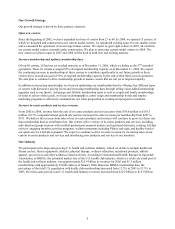Lifetime Fitness 2006 Annual Report Download - page 21
Download and view the complete annual report
Please find page 21 of the 2006 Lifetime Fitness annual report below. You can navigate through the pages in the report by either clicking on the pages listed below, or by using the keyword search tool below to find specific information within the annual report.15
Our continued growth could place strains on our management, employees, information systems and internal
controls which may adversely impact our business and the value of your investment.
Over the past several years, we have experienced significant growth in our business activities and operations,
including an increase in the number of our centers. Our past expansion has placed, and any future expansion will
place, significant demands on our administrative, operational, financial and other resources. Any failure to manage
growth effectively could seriously harm our business. To be successful, we will need to continue to implement
management information systems and improve our operating, administrative, financial and accounting systems and
controls. We will also need to train new employees and maintain close coordination among our executive,
accounting, finance, marketing, sales and operations functions. These processes are time-consuming and expensive,
will increase management responsibilities and will divert management attention.
The anticipated benefits of operating additional leased centers may not be realized.
In July 2006, we entered into two lease agreements to operate seven health and fitness centers that were previously
leased and operated by another health and fitness company. We entered into new leases for these centers with the
expectation that we would be able to convert the members at these centers to memberships with us, retain the
employees at these centers as our employees and utilize operating efficiencies since six of the centers are located in
one of our existing markets. Achieving the anticipated benefits of these centers is subject to a number of
uncertainties, including whether we integrate these centers in an efficient and effective manner and continue to
retain the members and employees, and obtain planned operating effectiveness. Failure to achieve these anticipated
benefits could result in decreases in the amount of expected revenues and profits and diversion of management's
time and energy, which could materially impact our business, financial condition and operating results. We also
expect to invest at least $25 million in capital improvements over the next year and a half among the leased centers.
Any change in our expected schedule or costs for completing these improvements could impact our ability to retain
the members at these centers and our operating results.
Our debt levels may limit our flexibility in obtaining additional financing and in pursuing other business
opportunities.
As of December 31, 2006, we had total consolidated indebtedness of $389.6 million, consisting principally of
obligations under term notes that are secured by certain of our properties, borrowings under our revolving credit
facility that are secured by certain personal property, mortgage notes that are secured by certain of our centers and
obligations under capital leases.
Our level of indebtedness could have important consequences to us, including the following:
• our ability to obtain additional financing, if necessary, for capital expenditures, working capital, acquisitions
or other purposes may be impaired or such financing may not be available on favorable terms;
• we will need a substantial portion of our cash flow to pay the principal of, and interest on, our indebtedness,
including indebtedness that we may incur in the future;
• payments on our indebtedness will reduce the funds that would otherwise be available for our operations and
future business opportunities;
• a substantial decrease in our cash flows from operations or a substantial increase in our investment in new
centers could make it difficult for us to meet our debt service requirements and force us to modify our
operations;
• we may be more highly leveraged than our competitors, which may place us at a competitive disadvantage;
• our debt level may make us more vulnerable and less flexible than our competitors to a downturn in our
business or the economy in general; and
• some of our debt has a variable rate of interest, which increases our vulnerability to interest rate fluctuations.
In addition to the amount of indebtedness outstanding as of December 31, 2006, we had access to an additional
$36.2 million under our credit facilities. On January 24, 2007 we secured $105.0 million in additional mortgage
























